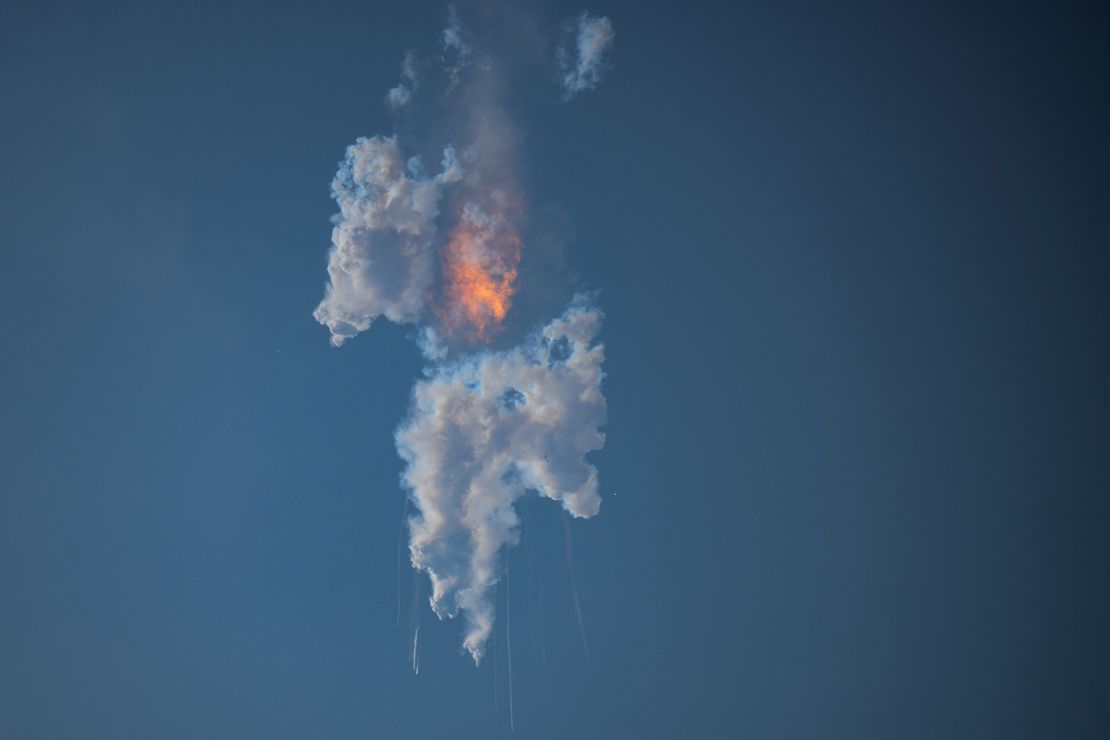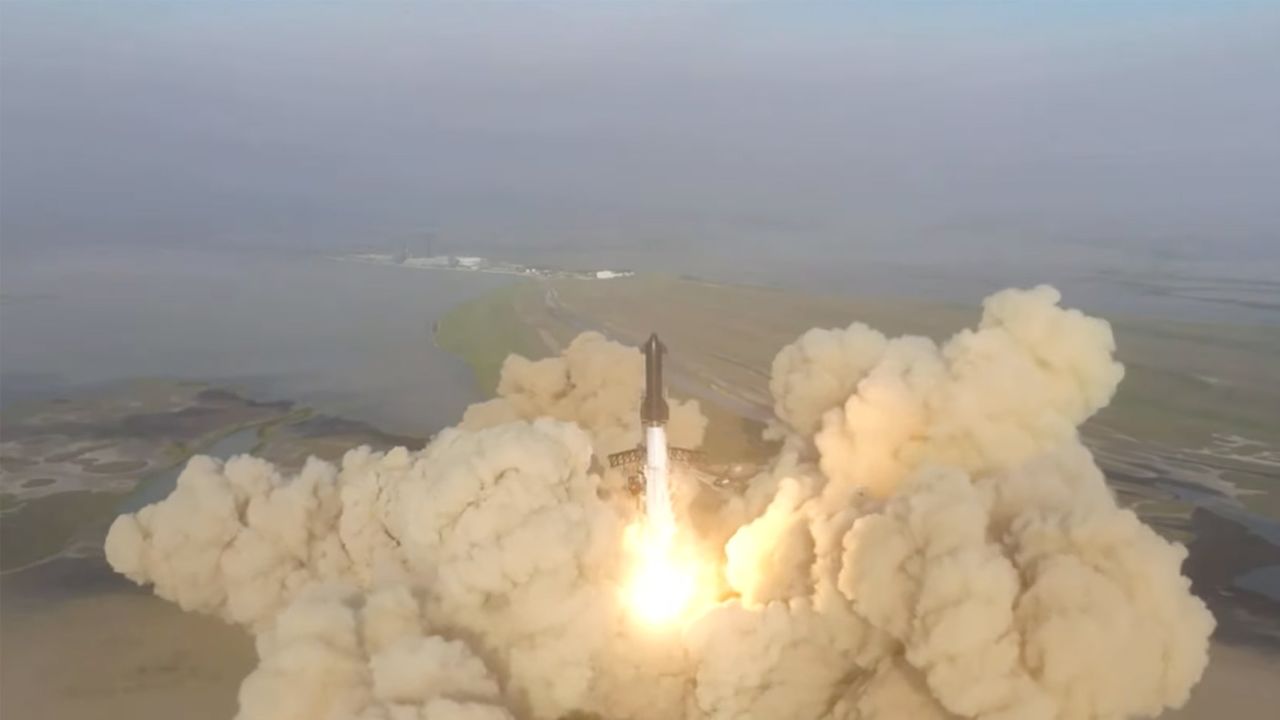Sign up for CNN’s Wonder Theory science newsletter. Explore the universe with news on fascinating discoveries, scientific advancements and more.
After the first test launch of a SpaceX Starship rocket — the most powerful launch vehicle ever constructed — ended in an eruption of flames over the Gulf of Mexico on Thursday, the company sought to frame the mission as a success.
“With a test like this, success comes from what we learn, and we learned a tremendous amount,” reads a post about the launch on SpaceX’s website.
That has long been the company’s ethos — carrying it through explosions of its early “Grasshopper” test vehicles, failed attempts to land rocket boosters and prior Starship testing mishaps.
So, was it a success or a failure, or some combination of both?
Within the space industry, Thursday’s Starship test mission wasn’t considered an outright failure, Caleb Henry, director of research at the space research firm Quilty Analytics, said.
“The expectation was just that — a test,” Henry said. “It’s important to fail during tests so that you have a greater chance of succeeding” in the future.
Overall, he added, the broader space community had a very favorable reaction.
“The industry is happy to see this program progressing,” he added. “Nobody is interpreting this as something that’s going to slow their roll … I think internally, it’s known that a test like this is not a setback.”
There are, however, downsides. One is the optics: It doesn’t help a company’s reputation to be associated with public and explosive mistakes. The optics problem can also turn into financing problems, said Dr. Garrett Reisman, a former NASA astronaut turned engineering professor and SpaceX consultant.
Still, SpaceX enjoys a pristine reputation in the space industry. And there’s a good reason why: The reliability of SpaceX’s Falcon rockets and Dragon spacecraft — which have been flying for years and even carry NASA astronauts to orbit — gives the company its vaunted status within the industry.
Money was lost in the Starship explosion, though it’s not clear how much. SpaceX remains a privately held company, and it’s not required to reveal its development expenses.
SpaceX CEO Elon Musk told CNN in 2019 that he believes the cost of developing Starship will be “closer to a two or three (billion dollars) than it is to 10 (billion).” NASA has also given SpaceX contracts worth up to $4 billion for two lunar landing missions, though that money is paid out as SpaceX hits certain milestones, Reisman said.
What happened Thursday
The Starship vehicle consists of two parts: The Super Heavy rocket booster, a 230-foot-tall (69-meter-tall) cylinder that houses 33 engines and gives the first burst of power at liftoff. The Starship spacecraft, which stands at 164 feet (50 meters) tall, rides atop the rocket.
The vehicle lifted off the launch pad near Brownsville, Texas, on the state’s southernmost tip. On ascent, some of the Super Heavy booster’s 33 engines unexpectedly shut down.
Starship is also supposed to separate from the Super Heavy booster after the rocket expends most of its fuel, but that never happened.
A few minutes after liftoff, the vehicle began tumbling, tail over head. Then, about four minutes into the flight, the vehicle flight termination system — or self-destruct — feature was triggered, blowing up the rocket to ensure it didn’t careen off course.

How SpaceX builds rockets
The reason SpaceX embraces fiery accidents lies in its approach to rocket development. In engineering terms, it’s called “spiral development,” and it’s not the same approach employed by NASA.
On a fundamental level, SpaceX does not seek to build a single rocket, test it strenuously on the ground and all but guarantee success on the first flight attempt, as is the traditional way of manufacturing rockets and how NASA developed its Space Launch System rocket.
“SpaceX is completely different,” Reisman said.
There isn’t just one Starship vehicle that’s spent years in the development pipeline. The company has thrown together a fleet of the vehicles, tweaking each one as testing continues. Because the vehicles are relatively quite cheap, it’s not a huge setback if one explodes. Rather, the explosion offers crucial data that informs how the design will change moving forward.
“If you look at anybody else, they take a decade or more, to develop a rocket,” said John Muratore, who spent 24 years with NASA at the Johnson Space Center in Houston, worked at SpaceX for a decade, and is now an engineering consultant. “We put out new versions and improvements all the time.”
SpaceX already has a lineup of new Super Heavy boosters and Starship spacecraft to test.
The SpaceX rocket that flew on Thursday “was really just a bare bones,” Reisman added. There were no fancy accoutrements, no seats for passengers, no valuable satellite in the cargo bay.
“You’re not trying to build it in its final form…because what we wanted to know are the big things: Do the engines work? Do the structures work? Do the flight computers and the avionics and the software work?” Reisman said.
Muratore said engineers refer to that type of “bare bones” vehicle as the “minimum viable product,” and they’re designed “to answer the question of an unknown” — purely to better inform future vehicles.
“The thing that kills (engineering projects) all the time is unknowns,” he said. “You wind up spending huge amounts of money trying to quantify unknowns.”
SpaceX’s approach seeks to accept more risk in the name of getting answers to those questions.
To put it simply: SpaceX’s rocket explosion wasn’t the disaster it may have appeared to be. Rather, it’s a baked-in expectation that comes with the methods the company’s engineers employ, according to Reisman and Muratore.
What happens next
Muratore said engineers will be pouring over the data that was gathered on Thursday’s flight. Many things were tested for the first time: Attempting to fire up 33 massive Raptor engines at the same time for a flight test had never been done before. Using methane for fuel is also a new approach for SpaceX. And the vehicle is made of steel while other rockets typically use lighter metals and carbon composites.
Musk even suggested heading into Thursday’s test that he would consider it a success if the rocket cleared the launch tower — and that did happen.
Next, SpaceX will be looking to pinpoint exactly what went wrong.
Muratore said engineers will be analyzing data from the Raptor engines. Among the questions they will be asking: How did the vibrations affected the flight? What temperatures were reached inside propulsion systems? And breaking down the overall behavior of the vehicle: How did its on-board guidance perform? Why was it tumbling?
The company will also assess damage to its launch pad and surrounding infrastructure and gear up for another flight.
Musk said in a tweet that could take a “few months” — though he is known to broadcast unmet deadlines.








